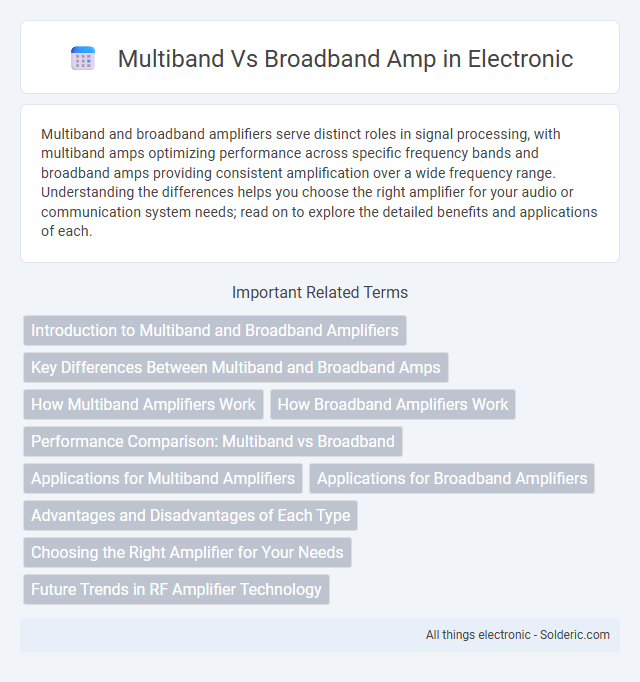Multiband and broadband amplifiers serve distinct roles in signal processing, with multiband amps optimizing performance across specific frequency bands and broadband amps providing consistent amplification over a wide frequency range. Understanding the differences helps you choose the right amplifier for your audio or communication system needs; read on to explore the detailed benefits and applications of each.
Comparison Table
| Feature | Multiband Amplifier | Broadband Amplifier |
|---|---|---|
| Frequency Range | Multiple narrow frequency bands | Wide continuous frequency range |
| Gain Control | Separate gain for each band | Uniform gain across entire band |
| Applications | Audio processing, noise reduction, equalizers | Wireless communication, general RF amplification |
| Complexity | Higher, due to multiple filters and controls | Simpler design, fewer components |
| Signal Distortion | Lower distortion by targeting specific bands | Potentially higher distortion in wideband signals |
| Cost | Generally more expensive | Typically more cost-effective |
Introduction to Multiband and Broadband Amplifiers
Multiband amplifiers optimize signal amplification by dividing the frequency spectrum into multiple bands, allowing precise control and reduced interference across each band. Broadband amplifiers amplify a wide range of frequencies uniformly, offering simplicity and wide coverage but potentially less efficiency in handling noise and distortion. Understanding the distinctions helps in selecting amplifiers for applications such as wireless communication, audio systems, and RF signal processing where frequency-specific performance is critical.
Key Differences Between Multiband and Broadband Amps
Multiband amplifiers divide the frequency spectrum into multiple bands, processing each separately to reduce distortion and improve sound clarity, while broadband amplifiers handle the entire frequency range uniformly, offering simplicity and lower latency. Multiband amps provide superior dynamic range and control, making them ideal for complex audio signals, whereas broadband amps are preferred for applications requiring consistent amplification across all frequencies. The choice between multiband and broadband amplifiers depends on the specific audio processing needs, with multiband amps excelling in precision and broadband amps in straightforward amplification.
How Multiband Amplifiers Work
Multiband amplifiers work by dividing an audio signal into multiple frequency bands using crossover filters, allowing each band to be independently amplified and precisely controlled. This process reduces distortion and enhances clarity by tailoring amplification to specific frequency ranges, unlike broadband amplifiers that amplify the entire signal uniformly. Your sound system benefits from improved dynamic range and clarity, making multiband amps ideal for high-fidelity audio applications.
How Broadband Amplifiers Work
Broadband amplifiers work by amplifying a wide range of frequencies simultaneously, providing consistent gain across a broad spectrum without the need for tuning. These amplifiers use wideband transistors and feedback networks designed to maintain stability and flat frequency response from low to high frequencies. If your application requires handling multiple frequency bands efficiently, a broadband amplifier ensures seamless signal amplification across the entire bandwidth.
Performance Comparison: Multiband vs Broadband
Multiband amplifiers optimize performance by dividing the audio spectrum into separate frequency bands, allowing precise control and improved clarity in each range, which reduces distortion and enhances overall sound quality. Broadband amplifiers, while simpler and more cost-effective, amplify the entire frequency range uniformly, often resulting in less accurate sound reproduction and higher distortion levels under complex audio signals. For critical audio applications, multiband amplifiers deliver superior dynamic response and fidelity compared to broadband counterparts.
Applications for Multiband Amplifiers
Multiband amplifiers are essential in telecommunications and audio processing, enabling efficient amplification across multiple frequency bands simultaneously. These amplifiers improve signal clarity and reduce interference in applications such as wireless communication systems, broadcasting, and professional audio equipment. Your network's performance benefits from multiband amplifiers by supporting diverse frequency requirements without compromising overall signal quality.
Applications for Broadband Amplifiers
Broadband amplifiers excel in applications requiring wide frequency coverage, such as cable TV distribution, wireless communication systems, and RF signal processing. Their ability to maintain consistent gain and low noise figure across a broad spectrum makes them ideal for handling multiplexed or multi-channel signals simultaneously. This versatility supports efficient transmission in environments demanding broad bandwidth and linear amplification.
Advantages and Disadvantages of Each Type
Multiband amplifiers offer precise frequency control by separately amplifying different frequency ranges, resulting in improved sound clarity and reduced distortion; however, they tend to be more complex and costly compared to broadband amplifiers. Broadband amplifiers provide a wider frequency response with simpler design and lower cost, making them suitable for general applications but often sacrificing the fine-tuned audio quality and efficiency found in multiband setups. The choice between multiband and broadband amplifiers depends on specific audio needs, with multiband excelling in high-fidelity environments and broadband favoring versatility and affordability.
Choosing the Right Amplifier for Your Needs
Selecting the right amplifier depends on your audio requirements and environment: multiband amplifiers provide precise control over specific frequency ranges, enhancing clarity and reducing distortion in complex audio setups, while broadband amplifiers deliver a wide frequency response ideal for general, straightforward amplification tasks. Multiband amps are preferred in professional audio systems where detailed sound shaping is essential, whereas broadband amps suit simpler applications requiring consistent performance across all frequencies. Evaluating the specific demands of your audio system, such as the need for frequency-specific tuning or overall power efficiency, will guide the optimum amplifier choice for your needs.
Future Trends in RF Amplifier Technology
Multiband RF amplifiers enhance device versatility by supporting multiple frequency bands within a single unit, reducing hardware complexity and improving energy efficiency compared to traditional broadband amplifiers. Emerging trends emphasize the integration of machine learning algorithms to optimize signal amplification dynamically and the use of GaN (Gallium Nitride) semiconductors to achieve higher power density and thermal efficiency. Advancements in 5G and upcoming 6G networks drive innovation towards smarter, more adaptive multiband amplifiers capable of handling diverse, high-frequency signals with minimal distortion.
Multiband vs Broadband amp Infographic

 solderic.com
solderic.com